![]() 1st Battalion 22nd Infantry
1st Battalion 22nd Infantry ![]()
Randy Cox
Page 8
Events, animals, etc.
Events, Animals, etc.
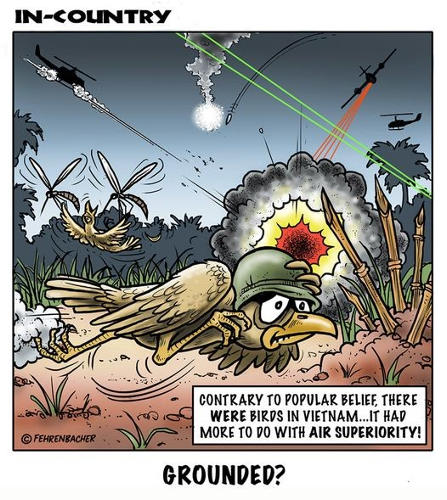
M79
The M79 grenade launcher is a single-shot, break-open, shoulder-fired weapon. It is breech-loading and fires a 40x46mm grenade. It has a protected fixed front sight and a rear leaf sight that is adjustable for windage. It was designed as a close support weapon for the infantry. Designed to close the gap between the maximum range of a hand grenade and the minimum range of a mortar, the lightweight M79 fired a 40x46mm projectile (primarily of a high-explosive fragmentation type) to a range of approximately 400 meters. It was used extensively during the Vietnam War, giving US troops the capability to engage enemy point targets to 150 meters and area targets to 350 meters. With two launchers per US Army rifle squad and a total of 85 in a US Army infantry battalion, the M79 helped to improve the capabilities of small infantry units.
The M79 has an open, fixed front sight and an open rear leaf sight that is adjustable for windage. The M79 grenade launcher was designed to fire a 40mm grenade more accurately than when fired from a rifle grenade launcher. The secret to the success of the M79 was a high-low pressure system that allowed the propellant to develop a relatively high pressure in, a high-pressure chamber, before venting gases into a low-pressure chamber in the grenade cartridge case.
Rifle mounted grenade launchers could deliver fire to point and area targets up to 350 meters away from individual soldiers. The M203 and M79 grenade launchers and the Ml 19 automatic grenade launcher could all fire smoke grenades. The smoke cartridges included the M713 red smoke, M715 green smoke, and M716 yellow smoke cartridges. Soldiers used rifle mounted grenade launchers to fire smoke in order to obscure snipers, enemy fighting positions, and heavy weapon emplacements. They could provide immediate suppressive smoke to degrade enemy weapon guidance links or tracking. They could also conceal the movement of small tactical units (squad or smaller).
Introduced in 1961, the M79 had been developed as an interim system as part of attempts to develop a grenade launcher as part of other weapon system development. The first of these Project NIBLICK, had been an offshoot of Project SALVO, an attempt to a weapon utilizing a hyper-velocity dart (otherwise known as a flechette) projectile fired in rapid bursts or salvos. This would eventually morph into the Special Purpose Infantry Weapon (SPIW) program, of which a grenade launcher component was to be a part. The M79 was intended to provide a stopgap until the SPIW, with its grenade launcher attachment, could be perfected.
By the time the US military became
formally engaged in the ground war in Vietnam in 1965, the M79
had no counterpart in the enemy's arsenal. It resembled a
sawed-off shotgun and fired a spherical 40mm grenade that had a
"kill radius" of 5 meters. Grooves in its barrel
imparted a spiral spin to the warhead stabilizing its flight. The
spiral also caused weights in the fuse mechanism to arm the fuse
after about 30 meters of flight, after which the shell detonated
on impact. The grenades were thus safe from accidental detonation
from a bump or fall, or if struck by a bullet.
Each shell is app. ½ pound each.
M79 |
Vest used in the field |
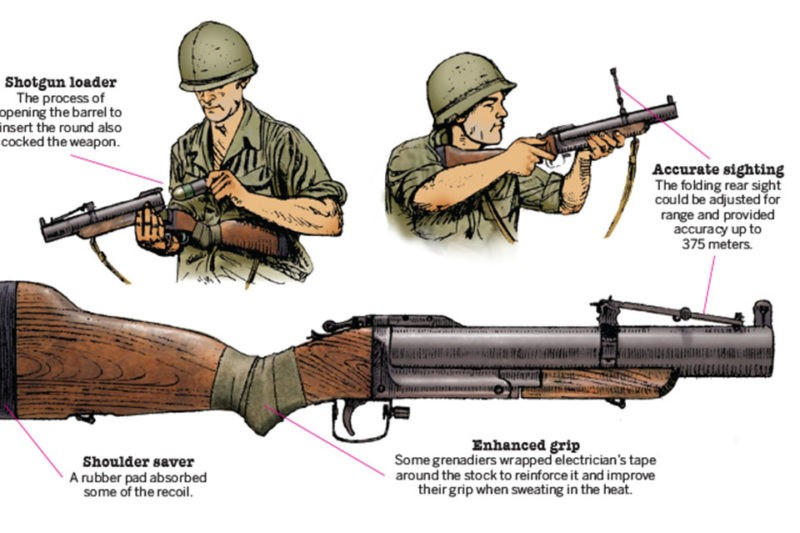
Events:
During the rainy season, we had a dog assigned to our platoon. Normally, they would scout the area checking for enemy sites and alerting us to any danger as we patrolled the area. We set up camp that night creating tents with our ponchos. On this occasion, we had three soldiers per poncho and rotated guard duty throughout the night. Under these conditions, we pulled guard duty within the tent and we all tried to stay awake and dry with difficulty. Normally, you would always be half asleep. During this period of my tour, we had an air mattress and as I sit/laid on my air mattress trying to stare in front of my area of responsibility. My eyes were heavy, and I was having difficulty keeping them open when I felt a heavy movement on my air mattress just in front of me. Within in seconds I was alert and about to do battle with the Viet Cong which had just stepped into our perimeter. I quickly accessed the situation and saw the dog was walking the area and happened to step on my mattress. I had no problem staying awake the remainder of my guard duty.
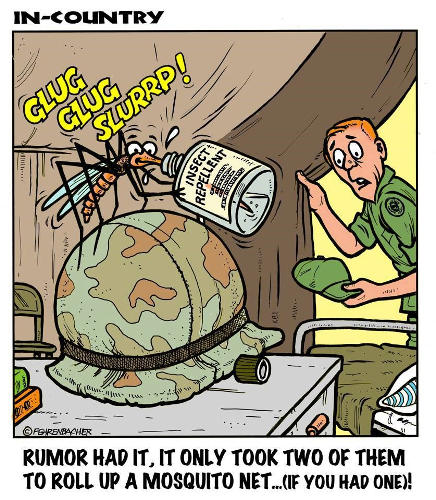
Our night visibility was limited because of it being monsoon season (rain), and/or tree canopy. One night I remembered putting my hand within 6 inches of my face and not see anything but the darkness. It was like being in the darkest cave I had ever been in.
|
|
Second part of a lesson concerning blowing things was learned months later as we humped through the mountains of Viet Nam. We were traveling in company size structure when we came upon a large bunker complex. This complex was in the flat land between a couple of ridges making it well hidden and would have been difficult to overcome if it had been manned by the enemy. Think of several of these units being placed with each having viewing capability of the other. It was made of logs, covered with dirt, and placed so they were difficult to see unless you got incredibly lucky. Not wanting to leave the bunkers in places for the enemy to reoccupy, a demolition team was brought in. We were warned to back out of the area to insure we were not hit by any of the flying debris. Remembering my previous episode with explosives, I found a large tree, sat behind the tree for protection. Why I did it I do not know but I think I sat on my helmet with my legs crossed in front of me, thinking the tree would offer protection. The tree did its job, but I forgot when items are blown up that is exactly what happens. Items go in every direction: up, down, and all around. My first hint I had made a bad decision was as items started falling around me, but the tree did its job until a small to medium rock landed on my boot. Remembering, I was sitting cross-legged on the ground and items continued to fall around me as I came to the realization that I had been hit and could be hit by larger items falling from the sky. With my back to the tree, I stood up keeping my back as close to the tree as possible and I adjusted my helmet trying to get as much coverage as possible. For what seemed like minutes’ items continued to fall around my tree but only one got my attention, the one that hit my foot.
|
|
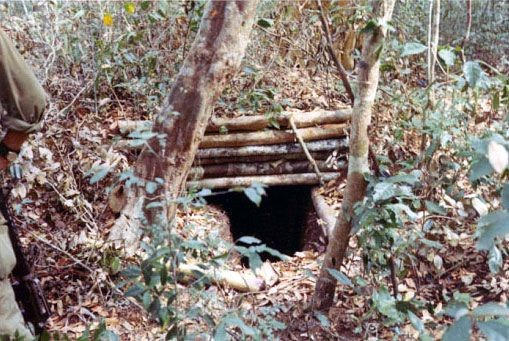
In another camp, there was a different environment. I remember marching into the camp as we relieved another company. I cannot remember much about the transfer of power, but I do remember the rumor that this camp got attacked prior to our arrival. The rumor was the camp got attacked with NVA, and Viet Cong coming in waves and there were so many killed they used a bulldozer to bury the dead. I never got that confirmed but we did stay on edge for many days. The concertina wire and razor wire around the firebase had large gaps, so large that it would be easy to walk into the camp and they did. In the daytime they would push the wire aside or step on the wire to get closer to the GI’s. Key point is there was little attention paid during the first installation and the wire was stretched out. Why you ask: to kill us, to gather intelligence, to open the wire for easier entry in the future. The answer was probably yes to everything. Was this allowed? They always had something to sell cokes, beer, liquor, dope, etc. They would get close and the GI’s would greet them with open arms buying and selling items. Dope was everywhere around the camps. The locals would get a pack of filtered cigarettes open the cellophane from the bottom removing the cigarettes and take out the tobacco replacing it with weed. Then they would reseal the package to an such an extent you would never know it had been tampered with. Now guess how much the pack cost-$5.00. Early on our duties were to reinforce the bunkers and to string new razor wire (Concertina wire). I got quite good at directing my men on how to do it. It was loose and created a formidable obstacle.
|
|
There were to many potheads in this firebase to feel safe It was not just our solders but the mortar crew, heavy artillery, and headquarters. Like in the movies, they would meet in a bunker smoke and get high. Remember, we were in bunkers on watch looking for the enemy to attack at any moment not that it happened, but it could have. During the day, we would have chores/duties and at night, when on guard duty it was kind of like a social hour for those not on guard. We would move between the bunkers talking, reading books, and writing letters. Naturally, the Potheads would gravitate to a single bunker or two. If you happen to walk into those bunkers, it would be full of smoke from weed blended with the camp odors, candle wax, odors from diesel fuel with human waste and local odors. Why did the commanders not do anything? Remember we were GRUNTS, we shot and got shot at. This might be one of the many explanations. It was hard to correct an environment created by years of acceptance even though they would try at times. Did I smoke pot? Did I stay in smoke filled bunker? No! Ok, one time. The way I evaded drugs was by declaring myself as a juice freak (alcohol). How could you be a juice freak? On rare occasions they would bring in beer and cokes giving you a choice of two cokes and two beers (Hamms). Hamms must have won the government contract to supply the army with beer. You could swap if you preferred one over the other. Also remember the locals coming through the perimeter, they always had beer and coke and not only that, they had COLD beer and cokes. If you wanted, you could buy bottles of liquor from the locals for as little as $5.00. Do you see the trend? Many things were available through the black market. This portion gets somewhat lost in my memories. I remember boarding the truck and in a long convoy going to another base camp, but I cannot remember why unless it was to get ready for the flight to Cambodia.
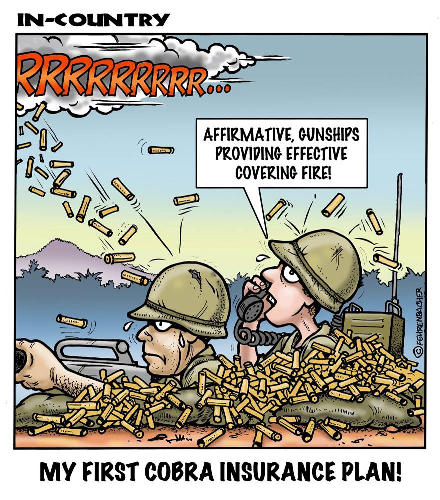



Butterflies, I remember this period so well for several reasons. We were in Happy Valley walking on a well-maintained trail which was well-worn and easy to walk on. Picture this flat land, large trees, a trail to walk on and white butterflies. Thousands and thousands of white butterflies up and down the valley. So many that you would put an arm out and touch several. They must have hatched that night and we just happened to be in the right place at the right time. Now think about the transformation from the beauty of this day to future events in the valley within the next couple of days. As we walked along, we came upon a mound of dirt which must have been several feet tall. Now what was this mound? A Viet Cong burial mount created by the enemy or American’s as the result of a kill. As we walked by, we could see the arm of a dead Viet Cong sticking out of the mount with his arm darken and fingers curled in death. Now, I talk about the contrast.
That night we set up camp and sent out an LP’s in several different directions to prevent someone from walking up on us. What did the remainder of the Company do? We set up camp, opened the C rations, wrote letters, and read a little in a book, which might be circulating around. I think I was reading 1/3 of “MASH”. When I say 1/3 sometimes, we would tear the book into parts sharing with others in a rotation. Read a book, eating C rations one moment and then BOOM you are throwing everything in the air-falling on the ground as you crawled with your weapon to a safe position. Quickly we responded the to the area of contact with each person in the area firing his rifle into the brush and woods. This continued for seemed like a lifetime, but it was over in less than one minute before the lieutenant ordered us to cease fire. The LP had set up a claymore land mine after arriving in their location prior eating. Thank goodness, they set up the claymores. They heard activity coming down the trail and reacted by grabbing the detonator, a palm sized block with a spring clip which prevented the handle from coming down preventing accidental detonations, throwing the clip and squeezing the handle blowing the claymore. Killing one Viet Cong and injuring others, which was evident by the blood trail. This was a weak blood trail which was followable but not heavy enough to lead us into believing the enemy was incapacitated. When there is a blood trail someone must follow it to find a body or decide that the injured person escaped. To put this in proper prospective think of shooting a deer and having to follow the deer blood trail but the deer having a rifle. My squad got the honors of following the blood trail. This is a slow process because behind every bush, tree, or mount this injured person could be lying with his rifle waiting or they could be setting up a large ambush for those who might be following the blood trail. My guess is we stalked him for 100 or 200 yards before we returned to the group after getting clearance from the commander.
|
|
About this same time there was another killing of a Viet Cong. We buried that person to the best of our ability. This one act, I had difficulty coming to grips with; we were at war, we killed people then we would bury them in the middle of the woods. To this day, it seems like the civil thing to do but it also seems like such a contradiction. Moving along, I and others were selected to bury the body. Remember, we are in a valley with large trees with many, many roots. Small shovels and larger roots meant we could not make a deep grave. After having dug the grave, we drug the body to the grave and covered him with a limited amount of dirt and leaves. This might explain why they bury their dead in a burial mound. You can image my feelings at the burial - happy to be burying him and not having to deal with one of ours.
At some point in Vietnam, our country gave us permission to start using booby traps. The Viet Cong had been using booby traps (IED’s) and they had the experience learned while fighting other countries such as the French, and knowledge of the local terrain. Often, we would be walking trails and off to the side would be crossbows made from bamboo. These would be aimed at the trail waiting for someone to trip the trigger whether it was a vine, cord, or piece of wire. We were lucky, most of the times they were old and had no strength, but I do remember someone having his rifle hit with a weak shot. Punji Sticks were sharpened section of bamboo about 12+ inches long put in the ground at an angle. The angle does not sound important, but it was. They would place them in an area of grassy weeds so that when you were walking through an area, they looked like grass. The angle was such that as you walked it was perfect to stab you in the leg below the knee. On one patrol we fanned out moving forward and entered an infected area of punji sticks. The soldier to my right walked into one having the punji stick go completely through this calf. For this action he was treated and put in a helicopter to be flown to the base camp for treatment. Often, the Vietcong would pee or worse on a bundle of stakes which would cause an infection assisted by our inability to bathe, our sweat, and we are in the mountains being exposed to who knows what. Almost at the same time, I walked into a stake. I was lucky. It hit the right side of my knee striking bone and not penetrating my leg. Did I say lucky? I had to stay in the field. This probably had a positive effect upon my tour of duty. Going forward, it was almost as if I had a sixth sense. Several times, I detected punji sticks early during a patrol thereby helping us evade the area. We learned their tactics and when punji sticks were available, and we would gather what we could and relocated them using them for our defense. We would put stakes down the trail from LP (listening post) in hopes of serving as a warning to us if we had an unexpected guest.
Our use of booby traps was not limited to the use of punji sticks, we were trained in the use of trip wires, 9-volt batteries and claymore mines. We would position the claymore facing down a trail and put a trip wire across trail, but I am to tell you it was very difficult to see even if we left it in plain view. A clothes pen was used as a trigger to separate the electrical charge of the 9-volt battery. Therefore, when you walked into the trip wire it would pull the buffer out allowing the battery to set off the claymore mine sending many metal balls down the trail. On one occasion, I had to set up the booby trap and had one of my FNG’s go with me. I cannot remember his name, but he was from Texas. Once, he got a package from home and instead of paper or other items acting as packing his family put Jalapeño peppers in the box. Anyway, I had him go down the trail to act as security. Feeling comfortable, I had it set correctly, I motioned him to come back. He did and he saw where I set the trip wire and walked into it activating the trigger. The bomb did not go off. The 9-volt battery was dead thanking God that was the case otherwise both of us would be dead. I determined the battery was dead by touching my tongue to the two post. If it were charged, I would get a strong tingle on my tongue if not I would not feel anything. I found out the battery was dead.

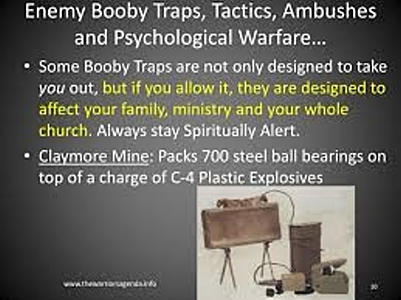
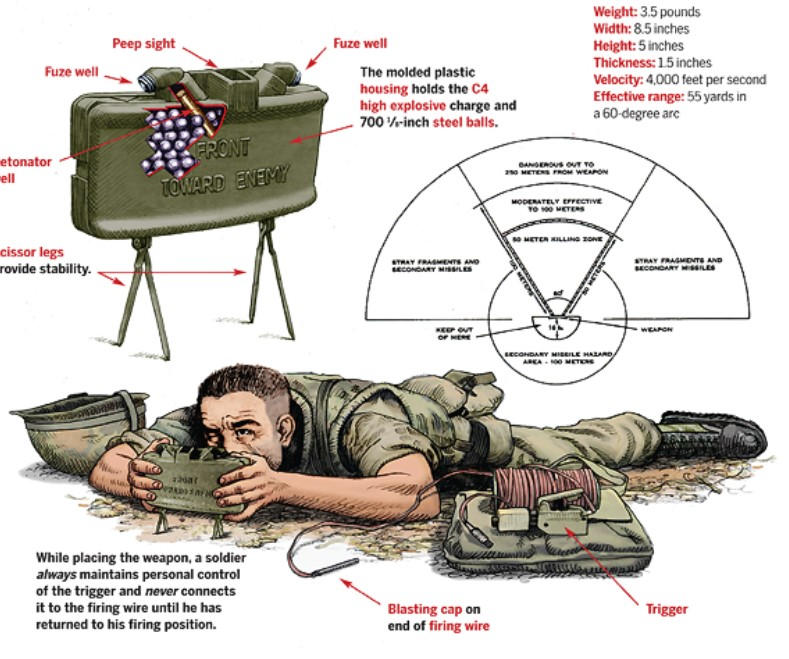
C/1/22
Once, we had a company size camp of app. 100 soldiers it was a rainy day and our location was on a small hilltop. Picture this; one hundred soldiers walking wet and grinding the water into the hillside. It was a muddy mess. I could take the rain, but I did not like mud. I was moving around with one of my friends when suddenly lightning struck the radio tower on top of the hill. We were on a hill, in water and I was walking up the hill toward the command post where the radio tower was located. Wet shoes were the perfect conductor as several of us felt a strong tingle in our feet as the electricity flowed to the lowest point. I dodged another bullet of a different type.
This was just before we abandoned this firebase and I with a small group were left behind as an ambush. Arrangements were made to helicopter everyone to the new camp, but a decision was made to leave a small ambush behind. As we vacate an area, we are never able to take everything, and this makes for great scavenging by the enemy. Several of us were selected to stay behind as an ambush. Yes, me and several others (Doc. Sorrento, John Bryce the M60 gunner, his assistance, the radio man, etc). Early, in the group’s departure from the firebase, we slipped into the woods through the wire surrounding the camp and the kill zone to the woods. The kill zone being an area of 40-100 yards of no vegetation offering material for anyone attacking the base to hide behind thereby making it difficult to attack the firebase or base camp without having a massive amount of manpower getting killed.
So, there we go through the camp, through wire, gates, and through the kill zone and into the woods. If anyone had been looking, we would have been an easy target as we departed. Our first objective was to find a location and dig in. The site we selected was flat and easy to dig I selected another soldier to help set up a booby trap with a Claymore Mine about 50 to 100 yards up the trail. Upon returning it was time for a radio check. I call for the radio man (RTO) to contact the base camp to which he received no response. Throughout the next 30 minutes and into the night we tried several times to make contact each with no response. This put us in a difficult position. Deep in the woods, surrounded by the enemy not knowing if they were aware of our location, no contact with our forces if we needed help and not knowing how we would get out. Ok, what’s next; we pulled our resources together and make decisions on what was necessary.
Number one; make our foxholes deeper. I do not know how we got it deep enough to stand in, but we did. Number two; check our rifles, ammo, and number three continue to do radio checks. For some reason one rifle did not work, the trigger would not dry fire. This is a memory I have blacked out but according to Doc’s book, we fired upon approaching enemy expending ammo and discovering the defective M-16. We did not obtain a KIA, but they did leave behind a pack and several pairs of shoes. It was getting dark about this time and priorities were around other items. When I had time to check on the rifle, it was dark, you cannot believe how dark it could get at night in the woods without moon light, and I had to repair a rifle. I only had one hope which was to open my poncho, lay on the ground, covering myself with the poncho and use a small flashlight for the repair. Here, I was doing everything I could to make sure light did not escape from under the poncho as I dismantle the trigger mechanism. I had small pins and springs to keep up with as the process evolved keeping low, allowing no light to escape from under the poncho and using two hands to work on the rifle. To this day I do not know how the springs got reversed nor how this rifle made it to the field. Was it from returning from R&R, from medical leave, or from a mistake of someone or having grabbed the wrong rifle?
Throughout the night, we would continue trying to make radio contact with no success. Often times, I would identify us and after not hearing a response would speak “HELP” at the end of the transmission. We survived the night without a problem, but we knew people would start to move around in the morning, this was the morning after the base camps departure and the Viet Cong would want to see what was left behind. WE had to be ready.

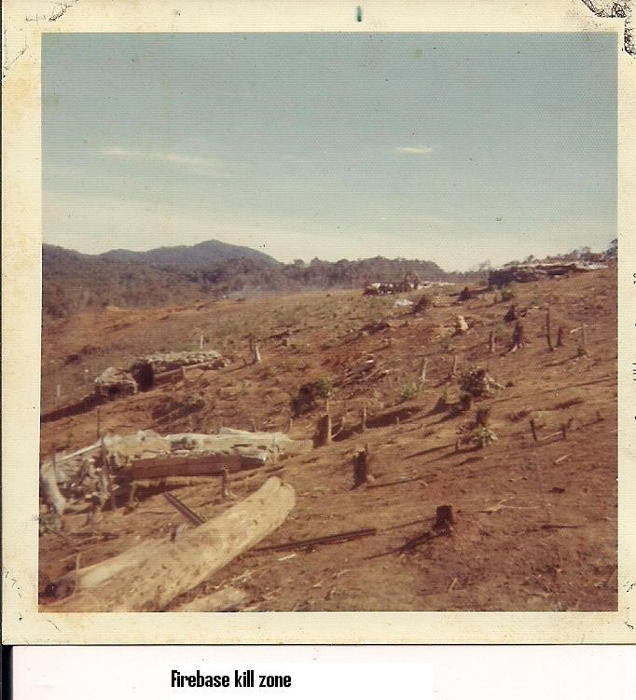
Photo by Randy Cox
Shortly after sunrise, there were three or four helicopters landing at our old base camp. Before that I had gone up the trail to check on the booby traps and to relocate them based upon on circumstances. As I walked back into our camp, I noticed the choppers and everyone motioning for me to hurry. I cannot remember how we decided to pack up, but we did carry what we could and ran to our safety. Extraction went without difficulty.
Later, I had to debrief the captain concerning the events of the night and if anything, had been detected. I had problems explaining why we left the booby trap behind and the location of the booby trap. Originally, they indicated where I was to locate the booby traps. I did not put the trap where it was suggested because it too far away from our foxholes, and why it was left behind. Next, he wanted to know why I could not identify its location on the map. I got a little upset explaining our predicament to the Commanding officer who sent us on such a dangerous ambush, and he let it ride. What happened to our radio? We discovered water had gotten into the unit allowing operation prior to our departure but interfering with reception after we got set up. We were lucky that night. As I always say, “I am Lucky, and God watched over me for some reason and he must have something greater in store for me or my family”.

Air missions are often the most unusual. Think about it you get in a helicopter taking off heading to a landing zone with numerous helicopters going to one spot giving the enemy a visual and sound indicator as to our location announcing our arrival.
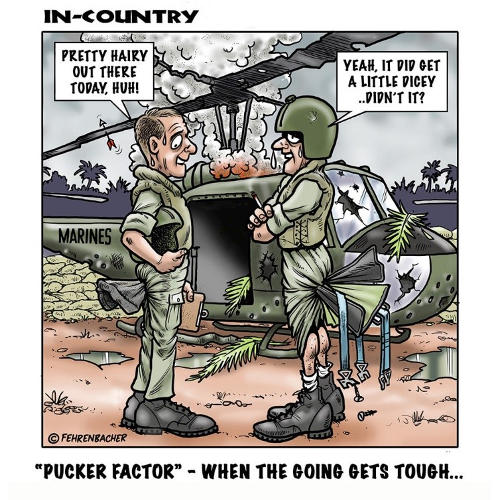
First, you are high above the ground sitting on the side of the doors with rifle in hand and rucksack on your back which could weigh upwards to 70-100 pounds depending upon the mission. This is the part I enjoyed the most looking down on the treetops having the wind in your face and feeling safe from all that goes on below. The flight is almost like a wide receiver in football trying to fake off the defender, the copter is high going in a straight direction then with a sudden movement the line of helicopters starts a quick drop in altitude heading toward the landing zone (LZ). As they briefly land all the soldiers jump off forming a perimeter for protection. One after another, this happens until the Company is on the ground. On the ground, we do a quick head and inventory count before moving out.
We go from a defensive perimeter to everyone getting up and we start the trek toward our destination. Which in this case was a trail located on a hilltop used by the enemy? The hilltop was a beautiful location-trees not too much under brush and on one side overlooking the valley. Temperature was comfortable, view great, and no action. A portion of the company was going on a patrol and I and others were to remain. This is where we made our mistake. The patrol went down one side of the trail and we failed to place distant listening post (LP’s). We had our foxholes dug but we were not attentive to the details. We were sitting around, talking, eating c-rations, etc. when suddenly, we were being shot at. The sound of bullets hitting trees had everyone jumping for the foxholes trying to see who was shooting at us and from what location. It was a short burst of gunfire, but it got our attention. We guess there two or three of the NVA were walking down the trail when they came upon us. They probably realize they were outnumbered but they wanted to kill, injure, or scare the Americans. From a protected spot, they fired off several bursts and ran for protection knowing there was a strong probability we would unleash all of our fire power in their direction. Our retaliation was short and controlled. All I can say is we were incredibly lucky that we did not get someone injured or killed. When the patrol returned, we reviewed our actions and how uneventful their patrol had been. This was part of a mission which had several events associated with it. In the mountains, walking trails like the hills of Alabama. So similar that if you closed your eyes you would think you were hunting deer or squirrels back home.
While based on Camp Hard Times, we had duties during the day and pulled guard duty or pulled patrols at night. On one occasion, a deuce and a half took us up the road to allow us to venture into the wilderness for a nighttime ambush. This was a common road with locals watching us as we get prepared to go on patrol. Surely, they would not tell the Viet Cong. If they were Viet Cong, they could be preparing for us as we exit or reenter the firebase in the morning. A lot of ambushes happen when you return. There was always a lot of local activity with men and women on small motorcycles traveling and stopping to see if they could service us, meaning sell drinks, smokes and/or offer boom boom girl services.
|
|
Our night was uneventful, and we arrived at the road the next morning waiting to be picked up. WE should have noticed this fact but there WERE no locals at this time around 9 or 10 in the morning. While waiting for our pickup a couple of South Vietnam trucks came by only to get ambushed about a ¼ to ½ mile down the road. We stood watching the action which only lasted about 1 minute. Our rules of engagement were to fire if fired upon or if we got permission. We continued to wait on our ride and behind us was farmland freshly plowed with no obstructions. You can guess our surprise as we saw 6-8 Viet Cong in their black pajamas silhouetted against the hill side maybe two or three hundred yards away. PERFECT firing range and perfect location. I was carrying the M-60 and oversaw the patrol. As we looked and called for permission to fire because we were in a yellow zone. The Viet Cong saw us then squatted down to see what we were doing. About that time, the LT in charge of the operation asked the magic question “Are they shooting at you”. My reply was NO, and his reply was “let them go”. About this time the Viet Cong stood up and ran into the wood line. It was like a western cowboy and Indian movie where they face each other and someone says, “Go in peace”. Damn war. But in the back of my mind I would like to think they gave us a little payback by letting one or two of our operations go unscathed. I do not know if it happened, but it was a nice thought.
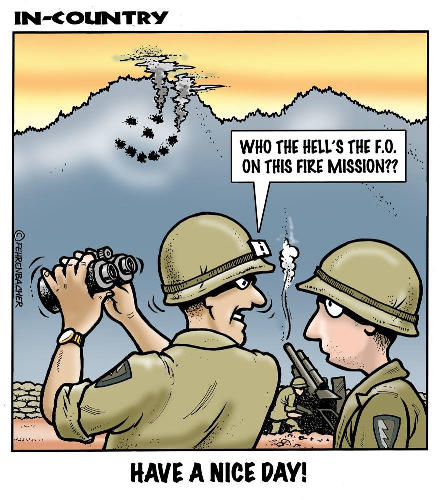
|
|
|
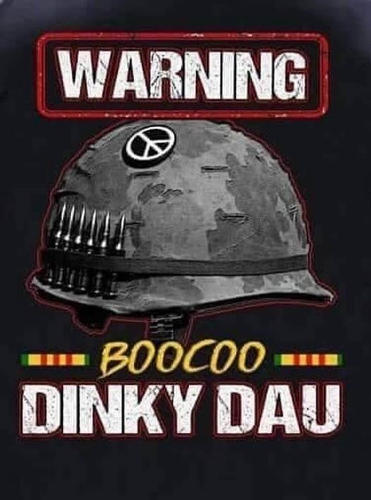 |
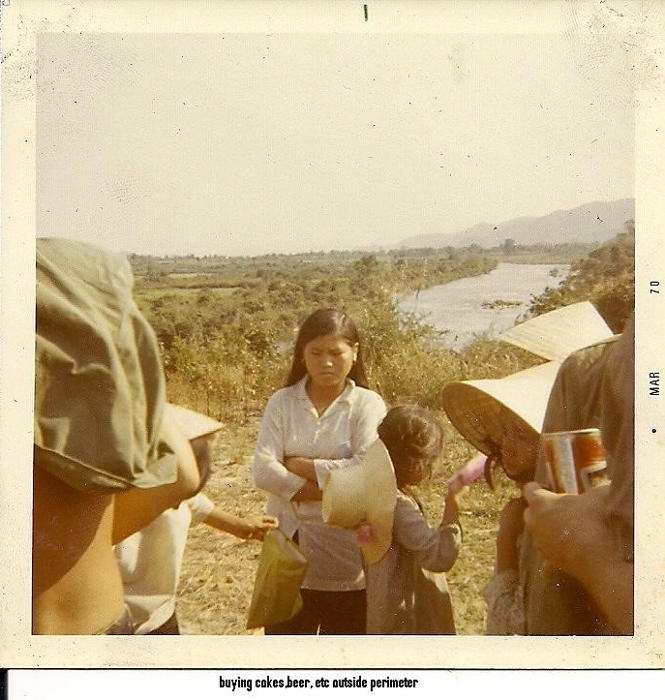
Photo by Randy Cox
Disclaimer and Copyright Notice:
All images attributed to Randy Cox are copyright © Randall D. Cox 2022.
All "In Country" cartoons are from the In Country Facebook page and are copyright © Phil Fehrenbacher.
All images not attributed to
Randy Cox used in the presentation are done so under the Fair Use
doctrine,
and are not intended as infringement upon the copyright of the
original owner or creator of the image.
They are used here by Randy for non-profit educational purposes,
to help illustrate his story.
If you are the owner of an image
used in the presentation for which there is no credit given,
please contact the website
at c22inf@cox.net so we may credit you as the source, or remove the
image, according to your wishes.
Home | Photos | Battles & History | Current |
Rosters & Reports | Medal of Honor | Killed
in Action |
Personnel Locator | Commanders | Station
List | Campaigns |
Honors | Insignia & Memorabilia | 4-42
Artillery | Taps |
What's New | Editorial | Links |